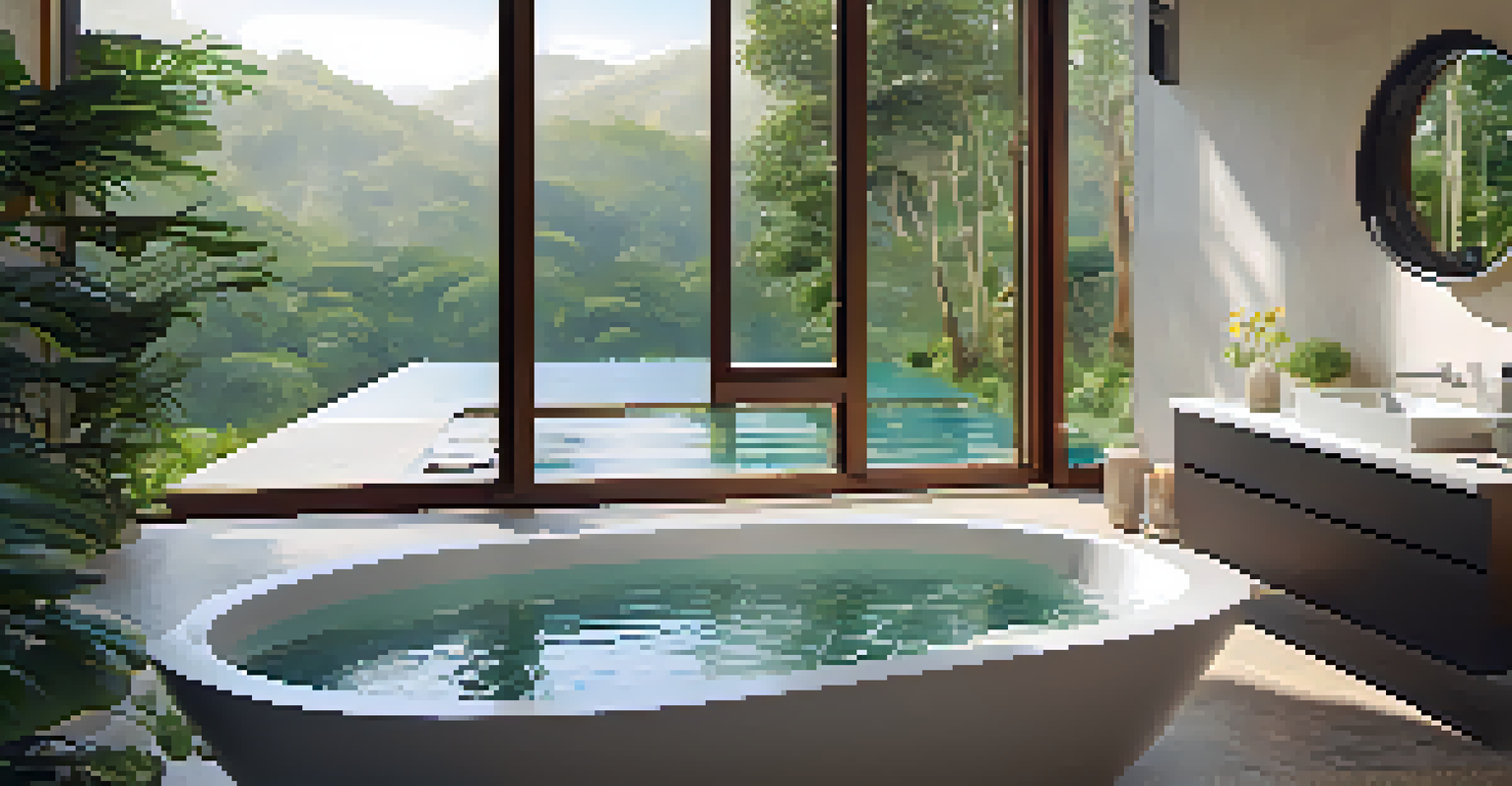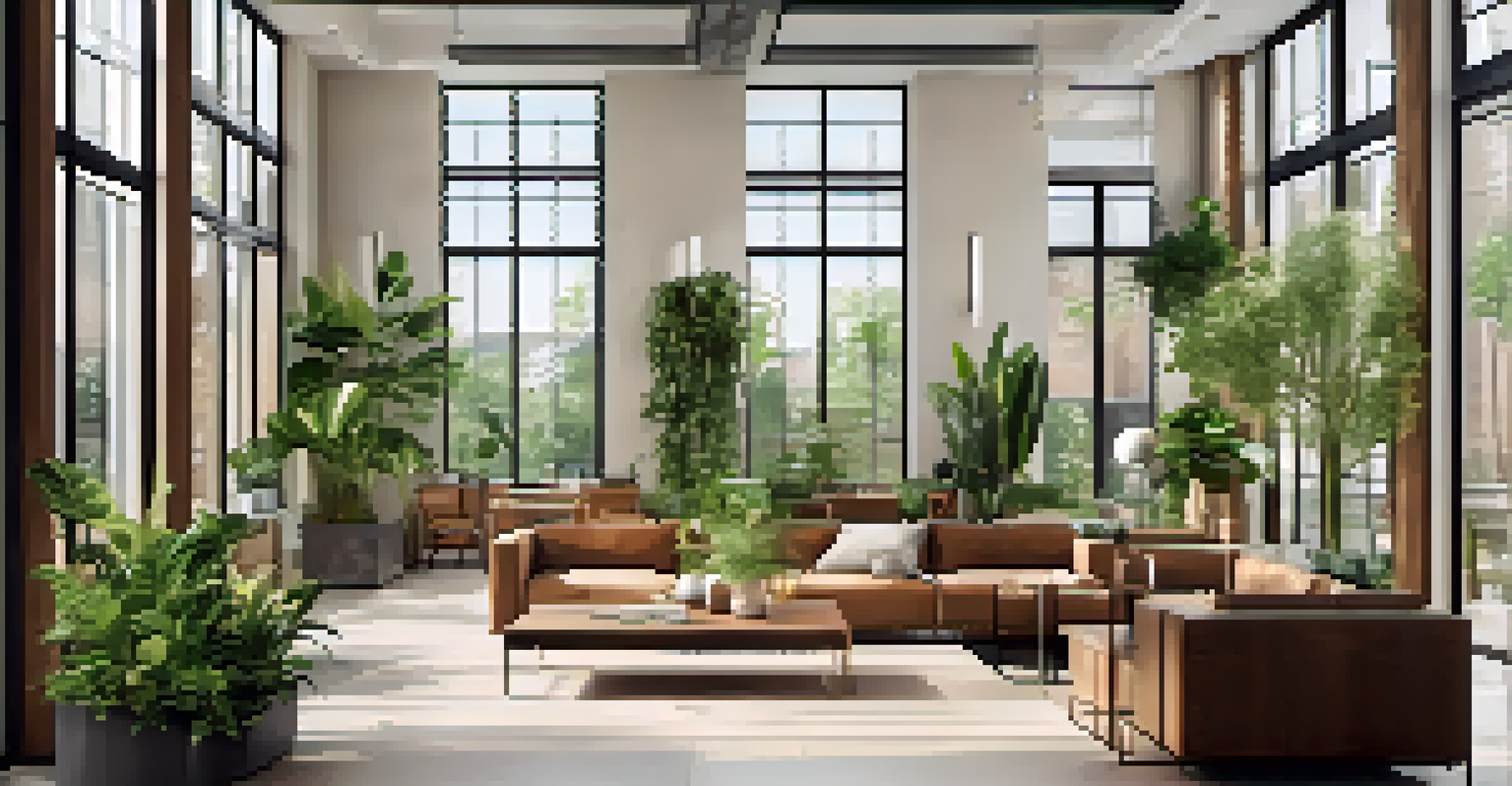Biophilic Design: Blending Nature with Modern Architecture

Understanding Biophilic Design and Its Importance
Biophilic design is an innovative approach that incorporates natural elements into modern architecture. It stems from the innate human connection to nature, often referred to as biophilia. This design philosophy not only enhances aesthetic appeal but also improves well-being by reducing stress and increasing productivity.
The future will belong to those who can see the possibilities in the world around them and translate them into design.
Incorporating biophilic design can take many forms, such as using natural materials, maximizing sunlight, or integrating greenery into spaces. For instance, a building might feature large windows that allow abundant light and provide views of lush landscapes. This creates a seamless transition between the indoors and outdoors, fostering a sense of tranquility.
Moreover, research suggests that environments rich in natural elements can lead to improved mental health and creativity. By promoting this connection, biophilic design ultimately aims to create spaces where people can thrive, making it a vital consideration in modern architecture.
Key Elements of Biophilic Design
There are several key elements that define biophilic design, including natural light, vegetation, water features, and organic shapes. Natural light plays a significant role in creating a warm and inviting atmosphere, while plants and greenery contribute not only to aesthetics but also to air quality. For example, incorporating indoor gardens can bring a refreshing touch to office spaces.

Water elements, such as fountains or ponds, can add a soothing quality to a space, enhancing the overall sensory experience. The sound of flowing water, for instance, can evoke feelings of calmness and relaxation. Likewise, using organic shapes and patterns inspired by nature can make a space feel more inviting and less sterile.
Biophilic Design Enhances Well-Being
Incorporating natural elements in architecture fosters a connection to nature, which improves mental health and productivity.
By blending these elements, architects can create environments that resonate with occupants on a deeper level. It's about crafting spaces that not only look good but also feel good, fostering a sense of connection to the natural world.
Biophilic Design in Urban Environments
As urbanization continues to rise, the need for biophilic design in city landscapes becomes increasingly crucial. Urban areas often lack green spaces, which can lead to feelings of isolation and stress among residents. By integrating biophilic principles, architects can transform concrete jungles into vibrant, inviting spaces that promote well-being.
Nature is the ultimate model for sustainable design.
For instance, rooftops can be transformed into green gardens or terraces that serve as communal spaces for relaxation. Additionally, vertical gardens on building facades can not only beautify the environment but also provide habitat for urban wildlife. These green initiatives help combat air pollution and reduce the urban heat island effect.
The incorporation of biophilic design in urban planning also encourages community engagement. Parks, green spaces, and nature trails can foster social interactions and a sense of belonging among residents. Thus, biophilic design not only enhances aesthetic value but also nurtures community spirit.
Biophilic Design and Sustainability
Biophilic design aligns seamlessly with sustainability initiatives, emphasizing a harmonious relationship with nature. By using sustainable materials and energy-efficient designs, architects can minimize the environmental impact of buildings. For instance, utilizing reclaimed wood or recycled materials can reduce waste while adding character to a space.
Additionally, biophilic elements can contribute to energy savings. Natural ventilation, for example, can reduce reliance on artificial heating and cooling systems, thus lowering energy consumption. This creates a win-win scenario where occupants enjoy a healthier environment while promoting eco-friendly practices.
Sustainable Practices in Design
Biophilic design promotes sustainability by using eco-friendly materials and energy-efficient systems to minimize environmental impact.
Furthermore, incorporating features like green roofs not only improves insulation but also aids in stormwater management. This sustainable approach showcases how biophilic design can be a powerful ally in addressing environmental challenges while enhancing the quality of life.
Biophilic Design in Residential Spaces
In residential architecture, biophilic design can transform homes into serene sanctuaries. By integrating natural elements, homeowners can create spaces that promote relaxation and connection to nature. For instance, incorporating large windows and sliding glass doors can seamlessly blend indoor and outdoor living.
Adding features like indoor plants, natural materials, and water elements can enhance the overall ambiance of a home. Imagine a cozy living room adorned with greenery or a tranquil bathroom featuring a small indoor fountain. These elements not only enhance aesthetics but also contribute to a sense of peace and well-being.
Moreover, biophilic design in homes can improve air quality and promote healthier living environments. By prioritizing natural light and ventilation, residents can enjoy a refreshing atmosphere that boosts their mood and productivity. Thus, biophilic design holds the potential to elevate everyday living.
The Role of Technology in Biophilic Design
Technology plays a pivotal role in enhancing biophilic design, offering innovative solutions to bring nature indoors. Smart systems can optimize natural light and ventilation, ensuring occupants experience the best of both worlds. For instance, automated window systems can adjust based on sunlight, maintaining a comfortable indoor climate.
Virtual reality (VR) and augmented reality (AR) technologies can also aid architects and designers in visualizing biophilic elements in their projects. These tools allow for immersive experiences, helping clients understand how natural features can transform spaces. This fosters better collaboration and creativity in the design process.
Urban Integration of Green Spaces
Transforming urban landscapes with biophilic design creates inviting spaces that enhance community engagement and reduce stress.
Additionally, technology can facilitate the maintenance of biophilic features. Smart irrigation systems can ensure that indoor plants receive the right amount of water, promoting healthier growth with minimal effort. Thus, technology and biophilic design can work hand in hand to create sustainable, nature-infused environments.
Future Trends in Biophilic Design
As awareness of the benefits of biophilic design continues to grow, we can expect exciting trends to emerge in the coming years. One such trend is the increased integration of nature-inspired aesthetics in both commercial and residential spaces. This includes using organic materials, natural colors, and design patterns that mimic the natural world.
Another trend is the focus on wellness-centered design, where the mental and physical health of occupants takes precedence. This may involve creating spaces that promote movement and interaction with nature, such as walking paths or community gardens. Architects are increasingly prioritizing these elements to foster healthier lifestyles.

Lastly, there’s a growing emphasis on regenerative design, which goes beyond sustainability by aiming to restore and enhance natural ecosystems. This approach encourages architects to think critically about their impact on the environment and to design spaces that positively contribute to their surroundings. As biophilic design evolves, it will continue to shape the future of architecture.